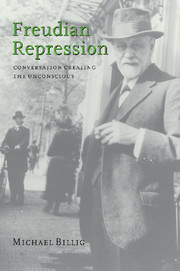Book contents
- Frontmatter
- Contents
- Acknowledgements
- 1 Introduction
- 2 The importance of repression
- 3 Thinking, speaking and repressing
- 4 Language, politeness and desire
- 5 Oedipal desires and Oedipal parents
- 6 Remembering to forget
- 7 Words of unconscious love
- 8 Repressing an oppressed identity
- 9 Ideological implications
- References
- Subject index
- Name index
3 - Thinking, speaking and repressing
Published online by Cambridge University Press: 22 September 2009
- Frontmatter
- Contents
- Acknowledgements
- 1 Introduction
- 2 The importance of repression
- 3 Thinking, speaking and repressing
- 4 Language, politeness and desire
- 5 Oedipal desires and Oedipal parents
- 6 Remembering to forget
- 7 Words of unconscious love
- 8 Repressing an oppressed identity
- 9 Ideological implications
- References
- Subject index
- Name index
Summary
When on the trail of the unconscious, it is easy to overlook the obvious. If one is searching for the processes of repression, then one might imagine that the clues are always to be found in the obscurest places – in dreams, in the oddities of neuroses, in startling slips of the tongue. Freud, however, argued that ordinary social life depended upon repression. That means that people are repressing as they go about their everyday business. If so, then the clues might be sought in ordinary, rather than extraordinary, activities. It would be a mistake, therefore, to isolate the depth psychology of psychoanalysis from the surface psychology of ordinary life.
One of the great strengths of Freud's metapsychological writings is that he attempts to link his psychology of unconscious thinking with a theory of consciousness. However, the strength is also a weakness. As will be shown in this chapter, his theory of consciousness is the root of many difficulties. It is directly related to the gap in his concept of repression. In order to reformulate Freudian ideas about repression, it is necessary to begin with the surface psychology, on which so much of the depth psychology depends.
Therefore this chapter will critically examine Freud's theory of consciousness.
- Type
- Chapter
- Information
- Freudian RepressionConversation Creating the Unconscious, pp. 38 - 70Publisher: Cambridge University PressPrint publication year: 1999



